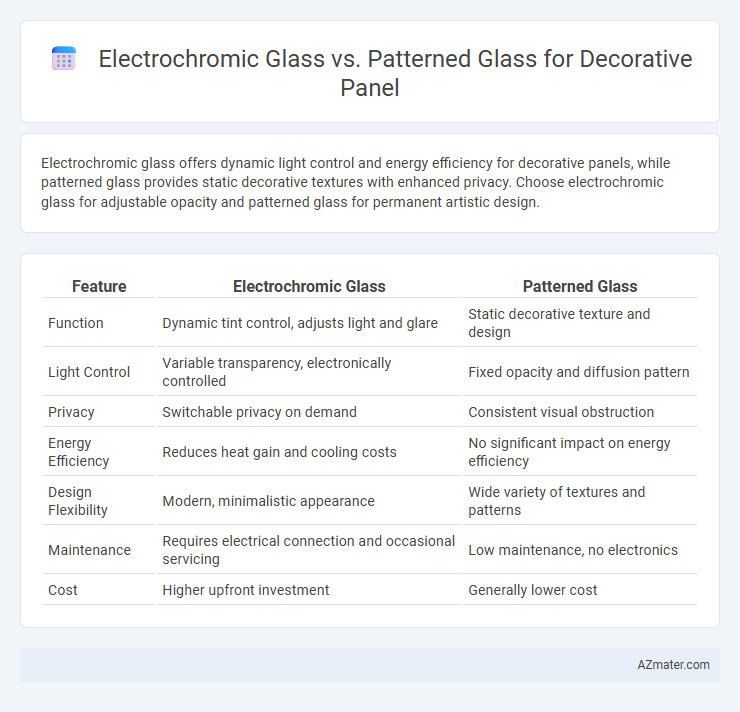Electrochromic glass offers dynamic light control and energy efficiency for decorative panels, while patterned glass provides static decorative textures with enhanced privacy. Choose electrochromic glass for adjustable opacity and patterned glass for permanent artistic design.
Table of Comparison
| Feature | Electrochromic Glass | Patterned Glass |
|---|---|---|
| Function | Dynamic tint control, adjusts light and glare | Static decorative texture and design |
| Light Control | Variable transparency, electronically controlled | Fixed opacity and diffusion pattern |
| Privacy | Switchable privacy on demand | Consistent visual obstruction |
| Energy Efficiency | Reduces heat gain and cooling costs | No significant impact on energy efficiency |
| Design Flexibility | Modern, minimalistic appearance | Wide variety of textures and patterns |
| Maintenance | Requires electrical connection and occasional servicing | Low maintenance, no electronics |
| Cost | Higher upfront investment | Generally lower cost |
Introduction to Decorative Panel Glass Options
Electrochromic glass offers dynamic light control by allowing users to adjust transparency and tint levels electronically, enhancing privacy and energy efficiency in decorative panels. Patterned glass provides a range of textures and designs that diffuse light and add aesthetic appeal through intricate surface treatments or printed patterns. Both materials serve distinct functional and decorative purposes, making them versatile choices for interior design and architectural applications.
What is Electrochromic Glass?
Electrochromic glass is a smart glazing technology that changes tint or opacity when an electrical voltage is applied, providing dynamic control over light transmission and privacy. Unlike patterned glass, which relies on fixed textures or etchings for decorative effects, electrochromic glass offers adjustable transparency, energy efficiency, and glare reduction in decorative panels. This innovation enhances building aesthetics while improving functionality, making it ideal for modern architectural designs seeking versatility and sustainability.
Understanding Patterned Glass
Patterned glass offers a variety of textured designs that enhance decorative panels by providing both aesthetic appeal and functional privacy without compromising natural light transmission. Its surface variations create unique visual effects and tactile experiences, making it a popular choice for architectural and interior design applications. Unlike electrochromic glass, patterned glass does not require electrical control and remains permanently styled, offering a low-maintenance, cost-effective decorative solution.
Key Aesthetic Differences
Electrochromic glass offers dynamic light control with the ability to change opacity or tint electronically, creating a sleek, modern appearance that adapts to lighting conditions. Patterned glass features static textures or designs etched or embedded into the surface, providing consistent visual interest and tactile detail that enhances architectural style. The key aesthetic difference lies in electrochromic glass's versatility and seamless transparency shifts versus patterned glass's fixed ornamental character and surface relief.
Light Control and Privacy Comparison
Electrochromic glass offers dynamic light control by adjusting its tint electronically to provide variable privacy and glare reduction, making it ideal for spaces requiring flexible shading. Patterned glass achieves privacy through static textures or etching that diffuse light while maintaining consistent translucency, but lacks adjustability. For decorative panels, electrochromic glass delivers superior adaptability in light modulation and privacy compared to the fixed opacity and pattern-based diffusion of patterned glass.
Energy Efficiency Considerations
Electrochromic glass offers dynamic energy efficiency by adjusting its tint to control solar heat gain and reduce cooling loads, making it ideal for adaptive daylight management in decorative panels. Patterned glass, while providing aesthetic variety and natural light diffusion, lacks the variable solar control capabilities, leading to less effective energy savings in changing environmental conditions. Selecting electrochromic glass enhances energy performance by minimizing HVAC demand and optimizing occupant comfort compared to the static properties of patterned glass.
Durability and Maintenance
Electrochromic glass offers high durability with a robust outer layer resistant to scratches and environmental wear, requiring minimal maintenance due to its self-tinting technology that reduces the need for cleaning. Patterned glass, while aesthetically versatile with etched or embossed designs, tends to accumulate dust and grime in textured areas, necessitating more frequent and careful maintenance to preserve its decorative appeal. Both options provide durability suited for decorative panels, but electrochromic glass stands out for its low-maintenance properties and long-term performance in dynamic light control.
Cost Analysis: Electrochromic vs Patterned Glass
Electrochromic glass typically incurs higher initial costs due to advanced technology integration and electrical control systems, making it more expensive than patterned glass, which relies on simpler manufacturing techniques like etching or printing. Maintenance expenses for electrochromic glass can include electrical component servicing, whereas patterned glass generally demands minimal upkeep. Over the long term, energy savings from electrochromic glass's dynamic light and heat control may offset its upfront price, whereas patterned glass offers a static appearance without such efficiencies.
Applications in Modern Interior Design
Electrochromic glass offers dynamic light control and privacy adjustment, making it ideal for modern interior spaces such as conference rooms and residential partitions where flexibility and energy efficiency are essential. Patterned glass enhances aesthetic appeal with its textured designs, commonly used in decorative wall panels, cabinetry, and room dividers to add visual interest and diffuse light. Both materials contribute to contemporary interior design by balancing functional performance with stylish customization options tailored to diverse architectural needs.
Choosing the Right Glass for Your Decorative Panels
Electrochromic glass offers dynamic light control and privacy with its ability to change transparency on demand, making it ideal for modern decorative panels that require flexibility and energy efficiency. Patterned glass provides permanent texture and design, enhancing aesthetic appeal and diffusing light without altering transparency, which suits static decorative applications. When choosing the right glass, consider whether your project prioritizes adaptability and tech integration, favoring electrochromic, or seeks consistent style and light diffusion with patterned glass.

Infographic: Electrochromic glass vs Patterned glass for Decorative panel
 azmater.com
azmater.com